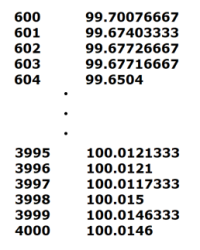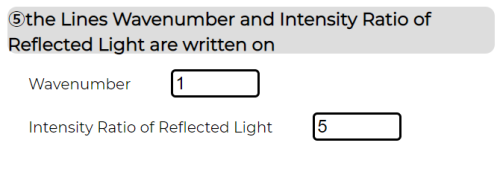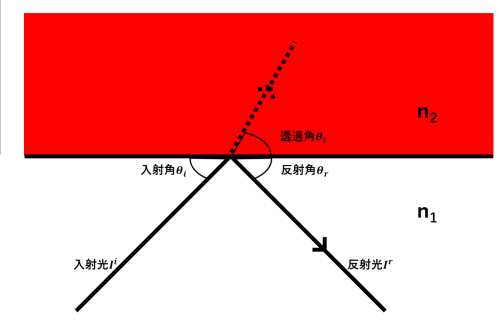「Input」の版間の差分
ナビゲーションに移動
検索に移動
| 4行目: | 4行目: | ||
<div id="Input02" style="font-size: 150%;">02:Input the file</div> | <div id="Input02" style="font-size: 150%;">02:Input the file</div> | ||
:You set the result file obtained from the ATR-IR experiment. The format is like below. | :You set the result file obtained from the ATR-IR experiment. The format is like below. | ||
: [[File: | : [[File:NewFILE01.png|200px]] | ||
:There are three rules for the format of input file. | :There are three rules for the format of input file. | ||
:First, the extension of input file must be the .txt. | :First, the extension of input file must be the .txt. | ||
| 25行目: | 25行目: | ||
:First, it is the wavenumber, and second, it is the representative absorptance or reflectance corresponding the former. | :First, it is the wavenumber, and second, it is the representative absorptance or reflectance corresponding the former. | ||
:For example, there is the input file like below.(You can download this file from Manual Page in ComplexRI. The file name is File03) | :For example, there is the input file like below.(You can download this file from Manual Page in ComplexRI. The file name is File03) | ||
: [[File: | : [[File:NewFILE03.png|200px]] | ||
: There are five columns. The first is the wavenumber, the others are all reflectance. The fifth is average of the second, the third and the forth. In this situation, when you input like below, you can get the better fitting result. | : There are five columns. The first is the wavenumber, the others are all reflectance. The fifth is average of the second, the third and the forth. In this situation, when you input like below, you can get the better fitting result. | ||
: [[File:manual_input5.png| | : [[File:manual_input5.png|500px]] | ||
:The default is set to the wavenumber to the first column and the reflectance or the absorptance to second column respectively. | :The default is set to the wavenumber to the first column and the reflectance or the absorptance to second column respectively. | ||
2021年12月19日 (日) 03:29時点における版
01:The name of output file
- This is the name of the output file. You can input freely. The default is set to ‘no-title’.
02:Input the file
- You set the result file obtained from the ATR-IR experiment. The format is like below.

- There are three rules for the format of input file.
- First, the extension of input file must be the .txt.
- Second, the wavenumber and the corresponding reflectance or the absorptance are ordered in the columns respectively, and counterparts are in the same line.
- Third, the columns are separated by the space.
03:Which kinds of data is written in the Input file, absorptance or reflectance?
- In the input file, there should be the wavenumber and the corresponding absorptance or reflectance. Please, input which data is written in your input file.
- There are two options.
- First, it is reflectance.
- Second, it is absorptance.
- The default is set to the first option.
04:The range of the wavenumber to fit the Reflectance Spectra
- In the input file, there may be all range of the wavenumber and corresponding data obtained from the ATR-IR experiment. Here, you input the range of the wavenumber to fit the reflectance spectra. ComplexRI execute the fitting only in the range you input here.
- The default is set to from 1636 to 1863.
05:The columns to use for analysis in the Input file
In the input file, there may be some columns of the wavenumber and corresponding data obtained from the ATR-IR experiment, but the columns necessary for the fitting is only two.
- First, it is the wavenumber, and second, it is the representative absorptance or reflectance corresponding the former.
- For example, there is the input file like below.(You can download this file from Manual Page in ComplexRI. The file name is File03)

- There are five columns. The first is the wavenumber, the others are all reflectance. The fifth is average of the second, the third and the forth. In this situation, when you input like below, you can get the better fitting result.

- The default is set to the wavenumber to the first column and the reflectance or the absorptance to second column respectively.
06:昇順か降順か?
- データの並び方を指定してほしい。これは波数の並び方が昇順か降順かを与えてほしい。
- デフォルトは降順になっている。
07:実験で用いた基質の種類
- 全反射実験で用いた基質の種類をInputしてほしい。これはn1の屈折率を指定することになっている。
- 選択肢は次の4つである。
- (1)diamond。屈折率は2.38と設定される。
- (2)zinc selenide。屈折率は2.40と設定される。
- (3)germanium。屈折率は4.0と設定される。
- (4)上記以外。これは屈折率を自由に設定できる。実際の実験で上記3つの基質以外を使った場合を想定している。しかし上記3つの基質のいずれかを使った場合でも、より厳密に屈折率を指定したい場合はこれを用いることも可能である。。
- デフォルトは(1)になっている。
08:入射角
- 全反射実験の光の入射角を指定してほしい。
- 上の図でいうところのである。
- デフォルトは45°になっている。
09:吸収がないときの屈折率
- 吸収がないときの屈折率をInputしてください。
- これはコーシーの方程式から計算できる。解析したい物質及び波数範囲に合わせて適切なパラメータ及び波長を与え、求めた値をInputしてほしい。
10:残差の指定
- ここでの解析を終了するための指標になる。内部処理の説明01:フィッティング方法で述べるように最小二乗法を繰り返し行い、残差がここでのInput値より小さいかどうかで解析の終了、続行を判定している。
- 注意!!小さすぎると終わらないことがある。
11:フィッティング関数のパラメータの設定の有無
- フィッティング関数の初期の本数およびパラメータの初期値を手動で与えるか自動で設定するかを選択できる。
- 自動の場合は内部処理の説明01:フィッティング方法で述べたように決定している。
- 手動で決定する場合は、まず、Lor_numにローレンツ関数の本数をInputしてほしい。最大は5となっている。
- 次に、Lor_numの値に応じて、INIT_A1, INIT_N1, INIT_G1と出てくる。これはローレンツ関数のパラメータに相当している。
- 最後の数字が同じINIT_A, INIT_N, INIT_G3つが一組となって一つのローレンツ関数のパラメータの初期を与えることになる。それぞれ、INIT_Aは, INIT_Nは, INIT_Gはに対応している。







